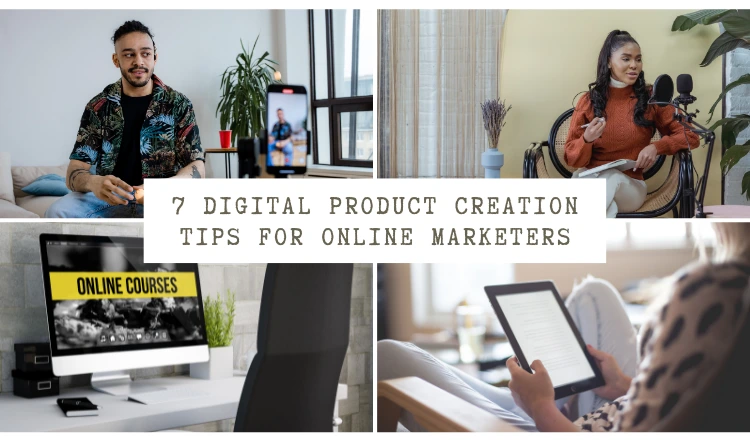Anyone who’s been trying to make money online for more than 2 minutes would have heard this line repeated ad nauseam – “You need to create your own product!”
Maybe 2 minutes is an exaggeration, but you get the idea.
Most marketers worth their salt know that there’s good money to be made by creating and selling their own digital products. Affiliate marketing is good, but owning and selling your own products is even better.
If you’re competent at traffic generation, you’ll get to keep 100 percent of the profits from the sales you generate. You can also recruit affiliates to promote your products and expand your market share while skyrocketing your income.
Once you’ve mastered product creation, the possibilities are endless when it comes to boosting your online income. As good as this sounds, there are a few fundamentals that must be in place for you to succeed at digital product creation.
1. Is there a market for your product?
This is without a doubt the most important factor of the lot. While creativity is a marvelous trait to have, trying to invent a new digital product that sells like hot cakes is infinitely more difficult than improving upon existing ones.
The case of not reinventing the wheel holds true here, and the key to succeeding with your digital product is to see what’s currently popular and selling well – and emulate these winning products.
You’ll create a similar product which addresses the same topic, but from a different angle. This is where your creativity needs to shine. You MUST have a unique selling proposition (USP) that makes your product stand above the unwashed masses of products that litter the marketplace.
Both Nike and Puma sell athletic shoes, but the former tells you to “Just do it!” with a swoosh symbol, while the latter is the only major sports manufacturing company on the planet with no slogan but lets the logo of the powerful leaping puma say all that’s needs to be said about the brand.
Similar products… but very different USPs.
Spend time researching and making notes on what products are selling well, and think of how you can improve upon them. Then go ahead and create a better product.
2. Spy on your competitors
Watching what your competitors do will help you navigate the marketplace and understand why some vendors excel and some fail.
Study their products, USPs, sales copy, sales stats (if available) and so on. Read through the customer reviews and see where their products are lacking.
Can you create a product that bridges the crevasse of customer dissatisfaction? If you can, you’ll have people flocking to buy your product.
3. Niche down
Once you’ve done your market research, it’ll be time to niche down and create a product for a specific topic. So many newbies falter here and make the cardinal error of trying to create a 5000-page magnum opus that aims to fix ALL ills in that niche.
Calm down. You’re not writing a dictionary. The best way to create a digital product that sells well is to target one specific problem and provide a specific solution.
Need to lose weight? Here’s a weight loss book with a 5-step plan.
Want to get build a chicken coop? Here’s a manual with 50 chicken coop plans and instructions you can use today.
Specific problems and specific solutions. That’s your secret to creating a digital product that’s not only valuable, but doesn’t overwhelm the reader either.
4. Create a customer avatar
Your digital product is not the bible. It’s not supposed to be for everyone. You must create a product that addresses a specific type of person.
You’ll need to construct a customer avatar before you start working on your product.
For example, if you’re writing a weight loss book, is it going to be for women? How old will the reader be?
Is she going to be a stay-at-home mom or a busy career woman? Will she have a lot of time to exercise or will she need quick workouts that don’t last for more than 20 minutes?
So many questions and so few answers.
What do you do?
Simple. You hang out in forums where your target market congregates. Spend time reading their questions, issues, comments, etc. This will help you to understand their problems intimately and you’ll have a finger on the pulse of your market.
Now you’re ready to create a product that speaks to them better than their best friend could.
5. Structuring your content
This is the part where you create your product. It goes without saying that you should produce the best possible product that you can. Aim for excellence, NOT perfection.
Your content should be broken down into bite-sized chunks. Your entire book shouldn’t be one long, never-ending paragraph. It’s better to have shorter, ‘compartmentalized’ chapters dedicated to specific topics.
If you’re using video, it’s ideal to break down a 1-hour-long video into six manageable 10-minute videos. In our noisy world, so many people have the attention span of a housefly. So, you want your content to be short enough to hold their attention, but long enough to give them the information they need.
6. Provide the content in different formats
Times have changed. PDFs alone are not enough. Some people prefer reading. Others prefer watching videos… and many like listening to audios. This explains why even when you purchase a book on Amazon Kindle, there’s usually an option to get the audiobook on Audible.
Provide your digital product in different formats (text, audio & videos) so that you capture as many customers as possible without inadvertently excluding any. Of course, you may choose to sell your audios and videos at a higher price.
7. Know your pricing
Last but not least, you’ll need to price your product according to what the market is willing to pay. If you overprice it, you’ll alienate most of your potential customers, and those who do buy it may feel like they’ve not gotten their money’s worth because they expect a lot more.
If you underprice it, you’ll be devaluing your product and leaving money on the table.
It’s best to look at what’s currently selling well and jot down the prices. You can then charge a similar price and occasionally offer a discount to get more attention to your offer. Everyone loves a deal.
To conclude, once you have these 7 fundamentals in place, and you have a great product to sell, you’ll then need to market it well… but that’s a whole different topic for another day. For now, get the product creation basics right, and it’ll be half the battle won.





